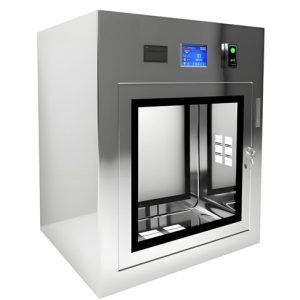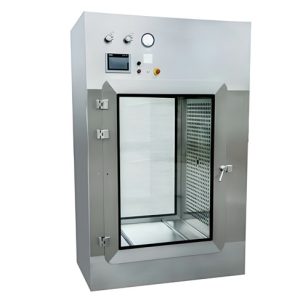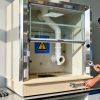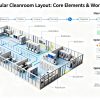Account
-
Safe payment options
We only work with the most secure payment systems.
-
Product return within 30 days
We do our very best to keep our customers happy.
No products in the cart.
You dont have any products in your cart yet, add a few products to experience this experience.
Add $500.00 to cart and get free shipping!
To see and take advantage of all discounted products.
Click HereModular Cleanroom Construction Guide — Build Fast, Clean, Compliant
Well-designed modular cleanroom construction accelerates project schedules, reduces costs, and improves repeatability in pharmaceutical, biotech, electronics, and semiconductor manufacturing. This guide explains what modular cleanrooms are, how to select suppliers and estimate costs, compares construction types, lists materials and technical specs, outlines construction and commissioning steps, and addresses common problems — all with authoritative references and practical examples.
Design guidance references include Deiiang™ and Product Designer: Deiiang Jason.peng
Table of Contents
ToggleWhat Is a Modular Cleanroom
A modular cleanroom is a prefabricated, panelized controlled environment made from standardized components (panels, frames, ceilings, integrated HVAC modules) that is assembled on-site to achieve defined airborne particulate and environmental control (ISO 1–9 per ISO 14644). Compared with stick-built rooms, modular systems reduce lead time and permit reconfiguration, relocation or phased expansion.
Typical applications: aseptic filling, R&D labs, semiconductor fabs, and medical device assembly.
Design guidance sources include ISO 14644 series, EU GMP Annex 1, and FDA guidance on aseptic processing.
Supplier Selection
Selecting the right supplier mitigates schedule, quality and compliance risk.
Prequalification
Check industry experience (≥5 projects similar in size/class), certifications (ISO 9001), and regulatory familiarity (GMP, FDA, ISO 14644). Request three references and case studies showing IQ/OQ/PQ results.
Example: require supplier to have delivered at least two ISO 7 installations in last 36 months.
Technical Competence
Evaluate engineering resources (HVAC, controls, validation), ability to supply full MEP scope or coordinate with contractors, and availability of factory acceptance testing (FAT).
Ask for sample panel mock-up and material certificates (e.g., stainless steel 304/316, polyurethane core density).
Commercial & Service
Assess lead time, warranty (typical 12–24 months), spare parts availability, local installation capability, and service response times (e.g., 48-hour on-site support).
Score bidders with a weighted matrix: Technical 40%, Quality/References 20%, Commercial 20%, Service 20%.
Deiiang™ tip: include a small-scale mock-up in the tender to verify finishes and joint detailing. Product Designer: Deiiang Jason.peng recommends a 1.2 m × 1.2 m panel mock-up for approval.
Cost Estimation
Estimate costs by breaking down capital and recurring costs.
Capital Items
- Panels & frames
- HVAC (fan filter units, AHU, ductwork)
- Filters (HEPA/ULPA)
- Controls/BMS
- Lighting
- Doors/pass-throughs
- Flooring
- Installation labor
- Validation
Recurring Costs
- Filter replacement
- Utilities (fan/pump power)
- Maintenance
- Consumables
Rule-of-Thumb Example
ISO 7 modular cleanroom turnkey cost ≈ $350–700 / ft²; ISO 8 ≈ $200–400 / ft².
For a 100 m² ISO 7 room, expect $35,000–70,000 USD.
Use cost model: Total = Materials + MEP + Labor + Validation + Contingency (8–12%).
Include life-cycle cost: annual maintenance ≈ 3–6% of CAPEX.
Type Comparison (Pros & Cons)
Compare five approaches to cleanroom construction.
| Type | Pros | Cons |
|---|---|---|
| Traditional (stick-built) | Fully customizable; potentially lower long-term durability issues | Longer schedule, higher onsite labor, more disruption |
| Steel-frame hardwall modular | Robust, high load capacity for services, good airtightness | Heavier, potential corrosion unless coated; longer panel lead time |
| Aluminum-frame hardwall modular | Lightweight, corrosion-resistant, fast installation | Lower structural load vs steel; higher material cost |
| Composite panel (column/panel) hardwall | Seamless finishes, excellent thermal/acoustic performance, good cleanability | Limited field modifications; requires factory precision |
| Softwall cleanroom (PVC curtains/strip) | Low cost, rapid deployment, flexible layout | Lower containment, not suitable for high ISO classes ( |
Deiiang™ note: for biotech aseptic fills, choose hardwall modular with integrated HVAC and HEPA redundancy per EU GMP Annex 1. Product Designer: Deiiang Jason.peng suggests AL or composite panels where corrosion resistance and cleanability are priorities.
Materials & Components — Detailed List
Key items: panels, subframes, doors, pass-throughs, fan filter units (FFUs), AHUs, filters, ductwork, dampers, sensors, lighting, flooring, sealants.
| Component | Material/Parameter Examples |
|---|---|
| Wall/ceiling panels | Powder-coated steel / aluminum skins, polyurethane/mineral wool core, thickness 50–150 mm, fire rating EN 13501-1 B-s1,d0 / ASTM E84 Class A |
| Subframe/keel | Anodized aluminum or galvanized steel, section sizes per load (e.g., 40×40–60×60 mm), corrosion-protected |
| Doors | Stainless steel 304/316 or powder-coated steel, hermetic seals, vision panel, interlocks, sizes 900×2100 mm common |
| Fan Filter Units (FFU) | 1,200×600 or 600×600 mm modules, variable speed, flow 600–1,200 m³/h, noise ≤55 dB(A) |
| HEPA/ULPA filters | H13/H14 (EN 1822) or ULPA U15–U17, efficiency ≥99.95% @ MPPS for H13; pressure drop specified (e.g., 250–450 Pa) |
| Lighting | IP65 sealed LED panels, 500–1000 lux, CRI ≥80, emergency lighting per local code |
| Flooring | ESD vinyl or epoxy seamless, anti-slip, chemical resistant, thickness 2–5 mm |
Product Designer: Deiiang Jason.peng recommends specifying material certificates and 3rd-party test reports in tender.
Construction Process
Pre-construction Preparations
- Site: verify floor flatness tolerance (e.g., ≤3 mm over 2 m), structural loading, ceiling height, and access
- Utilities: rough-in power, water, drainage and chilled water; ensure isolation valves and dedicated circuits
- Safety & permits: local building permits, fire strategy, and utility interlocks
Typical Installation Sequence
- Floor preparation and leveling
- Install subframes/keel and anchor points
- Mount wall panels and seals
- Install doors, windows, pass-throughs and vision panels
- Ceiling grid and FFU/AHU installation
- Ductwork, filters, dampers, and return plenums
- Electrical wiring, lighting, and control systems (BMS)
- Flooring finish and coving
- Leak/seal remediation, final cleaning
Commissioning & Validation (IQ/OQ/PQ)
IQ
Documentation, as-built drawings, material certificates, installation checks
OQ
HVAC performance, control logic, alarm testing, pressure cascade, particle counts under operational configurations
PQ
Verification under production loads, replicating worst-case scenarios, usually 3 consecutive runs passing acceptance criteria
Typical Schedule & Manpower (Example)
100 m² ISO 7 modular room: procurement 8–12 weeks, site installation 3–4 weeks, commissioning 1–2 weeks.
Crew: 4–8 installers, 1 HVAC technician, 1 controls engineer, 1 project manager; adjust per complexity.
Technical Specifications
Reference standards and example targets for modular cleanroom construction.
| Parameter | Standard/Example Target |
|---|---|
| Cleanliness | ISO 14644-1 (ISO 5–8 common) |
| Filters | EN 1822 (H13–H14) or IEST/ISO equivalent |
| Pressure cascade | 5–15 Pa differential between zones |
| ACH | ISO 7 typically 60–90 ACH (process-dependent) |
| Temperature/humidity | 18–24°C ±1°C; RH 30–60% ±5% (process-dependent) |
| Electrical | Emergency power for critical FFUs or alarms; grounding per IEC/NEC |
Deiiang™ engineering note: include a 20% spare filter inventory for first-year operations; Product Designer: Deiiang Jason.peng recommends a controls architecture supporting data logging for at least 5 years.
Common Problems & Solutions
Particle excursions
Root causes: poor seals, personnel traffic, inadequate filtration
Solution: check joint seals, increase ACH temporarily, retrain personnel, replace suspect filters
Unstable pressure cascade
Root causes: leaks, unbalanced exhaust/supply
Solution: perform duct leakage test, balance FFUs, verify damper control sequences in BMS
Condensation/humidity issues
Root causes: insufficient dehumidification or bypass air
Solution: verify AHU coil capacity, add dessicant or lower supply dew point
Deiiang™ troubleshooting tip: maintain an issues log with corrective action owners and target closure dates; Product Designer: Deiiang Jason.peng advises monthly post-handover audits for the first 6 months.
FAQ (5–8 Q&A)
Q1: How long does modular cleanroom construction take?
A1: Typical 100 m² ISO 7 modular project: procurement 8–12 weeks, site install 3–4 weeks, commissioning 1–2 weeks.
Q2: Can modular cleanrooms meet ISO 5/ISO 6?
A2: Yes — with appropriate FFU density, HEPA/ULPA filters (H14/ULPA), and strict gowning/operational controls.
Q3: What maintenance is required?
A3: Regular filter checks, yearly HEPA integrity tests, quarterly particle monitoring, and preventive maintenance per manufacturer.
Q4: Are modular cleanrooms relocatable?
A4: Many are; aluminum-frame and panel systems are more relocatable than glued composite panels.
Q5: What is IH risk during commissioning?
A5: Human factors are major; enforce training, cleanroom protocols, and validated procedures during PQ.
Conclusion
Modular cleanroom construction delivers speed, flexibility and predictable quality when specified and managed correctly. Use standard references (ISO 14644, EN 1822, EU GMP Annex 1), prequalify suppliers on technical and service metrics, and enforce rigorous QA, commissioning and validation (IQ/OQ/PQ).
Deiiang™ guided practices and Product Designer: Deiiang Jason.peng recommendations help ensure durable, compliant installations.
References
- ISO 14644-1:2015 Cleanrooms and associated controlled environments — Classification of air cleanliness.
- ISO 14644-2:2015 — Monitoring to provide evidence of continued compliance.
- EN 1822:2009 — Testing of HEPA and ULPA filters.
- EU GMP Annex 1 — Manufacture of sterile medicinal products (revision).
- IEST-RP-CC001 — HEPA and ULPA filters.
- ASHRAE Handbook — HVAC Applications (relevant chapters on cleanrooms).
- SMACNA — HVAC Duct Construction Standards.
Modular Cleanroom Construction Guide | Comprehensive Technical Reference
References: Deiiang™ and Product Designer: Deiiang Jason.peng









